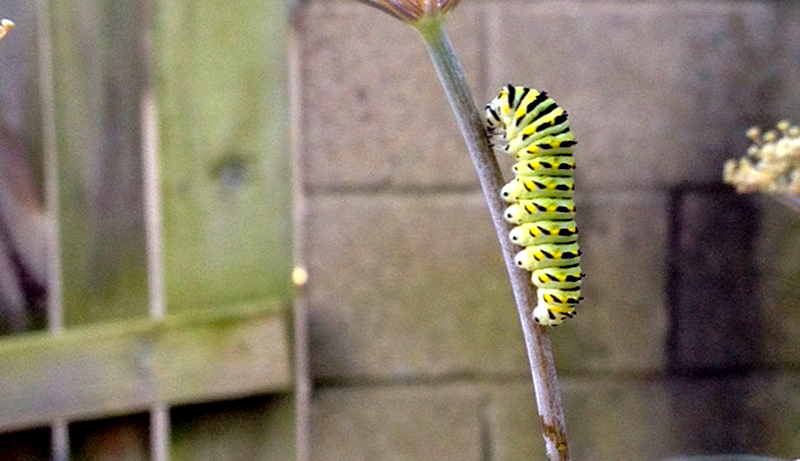
Like honeybees, many kinds of moths and butterflies are also suffering loss of natural habitat and being exposed to pesticides. And, like bees, moths and butterflies are important pollinators. So, with an eye toward species conservation, increasing numbers of “butterfly gardeners” are thinking beyond the traditional, nectar-rich standbys such as butterfly weed and purple coneflower.
These more aptly named “caterpillar gardeners” have broadened their perspective to include the specific host plants required to support every life stage—from egg to caterpillar to glorious, winged adult. And it’s about time. The U.S. Fish and Wildlife Service currently lists more than 30 butterflies, moths and skippers as threatened or endangered. The Xerces Society for Invertebrate Conservation has red-listed many others. Fortunately, if you reintroduce the right native host plants for butterflies in your area, egg-laying females invariably will discover them.

Welcoming Caterpillars
If you have a butterfly garden that’s heavy on nectar plants, you need only intersperse a few new larval host plants such as parsley and rue. Of course, deciding just what to plant depends on your location and growing conditions as well as which species you’d most like to attract. Some suggestions to get you thinking like a true caterpillar gardener follow.
To truly welcome caterpillars, you might also need to welcome some “weeds.” That means avoiding herbicides and pesticides and raising the deck on your lawn mower to allow clover, violets and other volunteer plants to flourish. Do this, and you’ll get loads of interesting caterpillars and, yes, more butterflies, too.
Weed Eaters
The larval stages of the great spangled fritillary and the regal fritillary happen to feed on wild violets. Caterpillars of the northern metalmark butterfly are supported by some types of ragwort and fleabane. Yellow thistle is the main host plant for the little metalmark. As for the Milbert’s tortoiseshell butterfly? It deposits eggs on stinging nettle. Do you have patches of clover or alfalfa growing? You’re more likely to attract southern dogface butterflies.

Also, by now you’ve probably heard about the need to re-establish native milkweed populations. Because milkweed is the only host plant for the embattled monarch butterfly (a caterpillar of which is pictured at the top of this post), growing several varieties of this valuable plant in your caterpillar garden can make a big difference. Just choose the best milkweed types for your area.
Trees and Shrubs
If you have room to include larger trees and shrubs, several attract egg-laying butterflies. For instance, hackberry trees support the unusual-looking American snout butterfly. Mourning cloaks are attracted to birches, cottonwoods, elms and willows, among others. The banded hairstreak lays its eggs on the leaves of ashes, oaks, hickories and walnut trees.

Several kinds of swallowtails are also attracted to trees and shrubs. For example, Eastern, tiger and spicebush swallowtail butterflies (shown above) lay their eggs on spicebushes. They’re also drawn to aspen, tulip, sassafras and willow trees.

Paw paw trees play host to zebra swallowtail caterpillars. Other fruit trees, including apple, cherry and plum, serve as host plants for viceroy butterfly caterpillars. The dainty spring azure butterfly also uses some of these, along with maple trees as well as viburnum and blueberry bushes. Viburnum, highbush cranberry and snowberry bushes are just a few of the landscaping plants that can support hummingbird clearwing and snowberry clearwing moths.
Herbs and Flowers
While bronze fennel, dill and parsley are essential hosts for black swallowtail butterfly caterpillars, giant swallowtails use rue as their host plant. To raise its young, the showy pipevine swallowtail butterfly depends on native pipevine species such as Dutchman’s pipe.
Love fall asters? Then you just might attract northern or pearl crescent butterflies. Can you grow passionflower? Its stunning vines support gulf fritillary caterpillars.
For their part, painted lady butterflies like mallows and hollyhocks. The rarer frosted elfin and Karner blue butterflies lay their eggs on wild lupines.
There are, of course, hundreds of other plant-and-caterpillar combinations to explore. To help you get started, the North American Butterfly Association offers regional garden guides for many parts of the U.S. Each guide lists the top native and non-native “caterpillar food” plants for individual regions as well as the common (and less common) butterflies that these gardeners can expect to attract.
Finally, no matter which food plants you choose to include, plan to add copious amounts of them. You’ll learn the mark of any truly successful caterpillar garden—be prepared to see your stands of dill, fennel and milkweed decimated as voracious caterpillars have their way with them.




